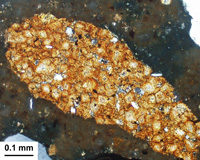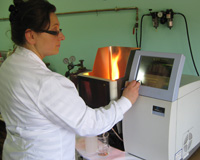


Mortar analysis starts with a petrographic examination so that all components may be identified through direct observation rather than inference. The photomicrograph here illustrates a residual particle of natural cement. The textures indicate a clay-rich dolomitic product consistent with most American cements of the 19th century. This information is passed on to the chemist so that a chemical procedure can be modified specifically for the identified mortar components. In this way, accurate partitioning of the individual components is ensured so that there is no guesswork when estimating original weight percentages.
A Highbridge chemist uses atomic absorption spectroscopy to measure the major elements of any binders identified in a historic mortar or stucco. These data are not only used to estimate mix designs but also to understand the physical properties of the mortar. Here, the nitrous oxide flame is used to determine soluble silica, an element associated with hydraulic binders. In this case, petrographic examination determined that a 19th century lime mortar was hydraulic in nature. By measuring the individual elements of the binder rather than simply determining the binder weight, the chemist is able to determine how hydraulic the lime was. This degree of detail cannot be gained from either simple acid digestion or x-ray diffraction analysis.
- Petrographic Examination is the first step in the analysis. The methods are based on direct microscopic observation meaning components may be identified without the need to interpret instrumental data. Binders may be accurately distinguished (e.g., natural cement vs. portland cement or shell lime vs. rock lime), sand mineralogies identified, and presence of pozzolanic materials are other additives detected. In addition to identifying components, petrography may reveal the presence and distribution of salts or mineral deposits, distinguish pore structures, and investigate causes of weathering or distress.
- Chemical Analysis is performed next with the sample decomposition method chosen specifically for the materials identified petrographically. Highbridge uses atomic absorption spectroscopy to measure the chemistry of the binder fraction as well as other wet chemical techniques for the sand, salts, or volatiles. The analysis is used to estimate the original component proportions and may often be used to evaluate the chemistry of the binder. For example, high calcium from dolomitic lime is easily distinguished and quantified as well as the degree of potential hydraulicity of the original binder.
- Acid Digestion is used to extract a sand sample. The petrographic observations are relied upon to suggest a concentration of acid and time of digestion sufficient to dissolve the binder and minimize the breakdown or discoloration of the aggregate. A gradation is also performed and in conjunction with the petrography the sand is fully characterized. Commentary may also be offered regarding the properties of the mortar affected by the gradation and shape of the particles.
Please contact us to learn more about the information that is gained from a mortar analysis. For a case study of the techniques, please see our paper with BCA’s Dorothy Krotzer entitled, “Analyzing mortars and stuccos at the College of Charleston: A comprehensive approach”. The paper received the Oliver Turrey Fuller Award for Technical Excellence and Innovation in a Bulletin Article from the Association for Preservation Technology in 2009.

